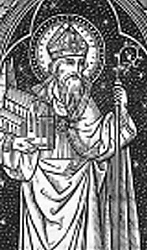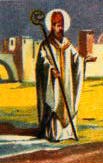
축일:3월26일
성 룻제로 주교
St. Ludgerus
San Ludgero di Munster Vescovo
c.743 at Zuilen, Friesland (modern Nederlands) -
in the evening of 26 March 809 (Passion Sunday) of natural causes;
buried at Werden; relics also at Munster and Billerbeck
Canonized:Pre-Congregation
보니파티우스(Bonifatius, 6월 5일)의 친구인 그레고리우스(Gregorius)가 지도하던 네덜란드의 위트레흐트 수도원 학교에서 교육을 받은 성 루드게루스(Ludgerus, 또는 루드제로)는 프리슬란트(Friesland) 사람으로서 프리슬란트와 색슨인들에게 복음의 씨를 뿌린 사람이 되었다. 그는 몸이 나약한 사람이었지만, 의지는 매우 강인하였으므로 사제가 된 후 프리슬란트로 가서 선교활동을 시작하였다. 그의 선교는 성공을 거두어 많은 개종자를 얻었고 이교 신전을 파괴하였다. 그 후 그는 알퀴누스(Alcuinus, 5월 19일)로부터 명을 받고 영국 선교에 나섰다가 로마(Rome)로 왔고, 다시 몬테카시노(Monte Cassino)에서 3년을 지냈지만 베네딕토 회원으로서 서원은 하지 않았다.
그는 성무일도에 특별한 신심이 있었는데, 여행 중이든지 무슨 일을 하든지 항상 성무일도를 먼저 바치는 것이 그의 습관이었다. 그리고 잠시도 쉬지 않고 일하는 사람이었다. 그는 임종 날 아침에도 미사 중에 강론하고 또 다른 성당으로 가서 봉사한 뒤에, 그날 저녁에 평화롭게 숨을 거두었다. 그는 프리슬란트, 색슨, 브룩테리 그리고 수에비인들에게 복음을 전한 이름난 선교사였다.
(가톨릭홈에서)
그처럼 영화를 자랑하던 로마 대제국도 4세기 민족 이동의 결과 허무하게 멸망하고,
쇠퇴해진 이 민족을 대신하여 유럽의 패권(覇權)을 잡은 것은 새로 일어난 프랑크 민족이었다.
자그만치 3백년 동안이나 로마 역대의 황제들에게 극심한 박해를 받아온 가톨릭교도
프랑크 민족에게는 종교의 자유를 얻어 기뻐할 수 있었고,
프랑크족에 의해 독일, 영국, 프랑스, 오스트리아 제국에 전파되었다.
그러나 독일의 서북 지방에 사는 프라시아 인이나 색손 인들은 가톨릭 선교사를 배반하고,
가톨릭교에 돌아올 기색이 보이지 않았지만 하느님의 섭리는 이상하여
이런 완교한 프라시아인 중에서 한 독실한 주교가 나타나
동포의 사도로서 눈부신 활약을 함으로써 드디어 그들의 대부분을 개종시키는 데 성공했으니,
이 사람이 바로 후에 성인이 된 룻제로이다.
그는 744년 그의 경건한 성격은 그의 가족의 내력이었는지도 모른다.
하여튼 룻제로는 어려서부터 신심이 깊었고
특히 성 보니파시오의 친구인 스레고리오가 지도하던 프리시아와 색손인들에게
복음의 씨를 뿌린 사람이 되었다.
룻제로는 영국에 건너가서 장남의 권리인 아버지의 백작위를 계승하는 것까지 단념하고
오로지 철학, 신학의 연구에 몰두하고,
부제가 되고 나서는 영국을 떠나 네델란드에서 사제품을 받았다.
주교에게 사명을 받은 룻제로는 성 보니파시오 순교의 지방(성인은 그를 만나고 나서 2,3개월 후에 순교했다.)에 가서 먼저 신자가 아닌 프리시아인을 개종시키는 일을 했다.
룻제로는 자기 사명을 전후 7년간 전심전력으로 수행한 결과
차차 세례를 받으며 가톨릭으로 개종하는 사람들이 많아져 만족하고 있을 때
색손인의 왕 위드긴도와 더불어 프리시아인도 프랑크 왕국에 대한 반란을 일으켰으므로
모처럼 보이기 시작했던 포교의 효과는 비참하게 수포로 돌아가고 말았다.

몬테 카시노 대 수도원
룻제로는 결코 실망하지 않았다. 그는 그것도 하느님의 성의라고 생각하고
사도 성 베드로와 성 바오로의 무덤이 있는 로마 지방을 순례하여
그들이 전교시에 당한 온갖 고통을 회상하며 다시 새 용기를 얻어
그 후 성 베네딕토가 창립한 몬테 카시노의 수도원에 가서 고요히 앞으로의 활동을 준비했다.
*독일의 사도 보니파시오 주교 순교자 축일:6월5일.게시판1197번.
*성 베네딕도 아빠스 축일:7월11일.게시판1267번.
☞http://home.catholic.or.kr/gnbbs/ncbbs.dll/chinchang

오래지 않아 독일로 돌아온 룻제로는 가를로 대제에게
프리시아 지방의 다섯 마을에서 전교하라는 명령을 받았다.
전에 그가 땀을 흘리며 뿌린 교회의 씨는 이제야 훌륭히 결실되어 환희 속에서 거둬들일 수가 있었던 것이다.
그러던 중에 수년이 지나서 도리르 주교가 서거하자 카를로 대제는
그를 그의 후계자로 추천했으나 겸손한 그는 이를 사양하고
그 대신 색손 지방까지 전교할 수 있는 허가를 신청했다.
카를로 대제도 그의 마음을 이해하여 아직 이교의 암흑 속에 빠져 있는 서쪽 색손 지방에 그를 파견했다.
그의 소망대로 이루어진 룻제로는 기쁘게 임지에 가서 많은 인내로써 색손인의 교화에 노력했다.
그 결과 그렇게도 완고했던 색손인도 그의 성심과 겸손, 온화한 태도에 감복하여
점차 가톨릭교의 진리에 귀를 기울이게 되었고,
세례를 원하며 신자가 되는 사람들이 많이 나왔다.
804년, 재차 주교로 천거 받은 그는 이번은 거절할 수 없어 취임을 승낙하고 그 뒤
고령의 몸으로도 불요 불굴의 활동을 계속하고 있던 중
809년 3월 26일 하느님의 부르심을 받아 그분의 품으로 가서 영복의 월계관을 받게 되었다.
그의 포교지였던 독일의 웨스트파렌이나 라인 지방은 이상하게도 1200년이 경과한 오늘에도
다른 지방에 비해 견고한 신앙을 보존하고 있는데,
이는 오로지 룻제로의 열심과 신앙심 덕분이라 할 수 있을 것이다.
(대구대교구홈에서)

♬사순절psalmus
LUDGER
Also known as
Liudger; Ludiger; Apostle of Saxony
Memorial
26 March
Profile
Son of Thiadgrim and Liafburg, wealthy Frisian nobles. Brother of Saint Gerburgis and Saint Hildegrin. Saw Saint Boniface preach in 753, and was greatly moved. Studied at Utrecht under Saint Gregory of Utrecht. Studied three and a half years in England under Saint Alcuin; deacon.
Returned to the Nederlands in 773 as a missionary. Sent to Deventer in 775 to restore a chapel destroyed by pagan Saxons, and to recover the relics of Saint Lebwin, who had built the chapel. Taught school at Utrecht. Destroyed pagan idols and places of worship in the areas west of Lauwers Zee after they were Christianized. Ordained in 777 at Cologne. Missionary to Friesland, mainly around Ostergau and Dokkum, from 777 to 784, returning each fall to Utrecht to teach in the cathedral school. Left the area in 784 when pagan Saxons invaded and expelled all priests.
Pilgrim to Rome in 785. Met with Pope Adrian I, and the two exchanged counsel. Lived as a Benedictine monk at Monte Cassino from 785 to 787, but did not take vows. At the request of Charlemagne, he returned to Friesland as a missionary. It was a successful expedition, and he built a monastery in Weden to serve as a base. Reported to have cured the blindness of, and thus caused the conversion of the blind pagan bard Berulef.
Refused the bishopric of Trier in 793. Missionary to the Saxons. Built a monastery at Mimigernaford as the center of this missionary work, and served as its abbot. The word monasterium led to the current name of the city that grew up around the house - Munster. Built several small chapels throughout the region. First bishop of Munster in 804, being ordained at Westphalia.
His health failed in later years, but he never reduced his work load. No matter how busy or dangerous his outside life, Ludger never neglected his time of prayer and meditation. The man’s life can be summed up in two facts: he was reprimanded and denounced only once during his bishopric - for spending more on charity than on church decoration; and on the day of his death, he celebrated Mass - twice.
Born
c.743 at Zuilen, Friesland (modern Nederlands)
Died
in the evening of 26 March 809 (Passion Sunday) of natural causes; buried at Werden; relics also at Munster and Billerbeck
Canonized
Pre-Congregation
Representation
bishop reciting his Breviary; bishop holding a cathedral; bishop with a swan on either side
San Ludgero di Munster Vescovo
26 marzo
Frisia, c. 745 - 26 marzo 809
Fu discepolo di S. Gregorio e di Alcuino. Divenuto sacerdote si dedico all’evangelizzazione. Nel 795 Carlo Magno riuni i territori della Frisia e della Sassonia in un unico vescovado su cui eresse il monastero di Munster, con la prima chiesa Cattedrale. Dopo aver creato presso la Cattedrale una scuola per il clero in cui insegno, Ludgero fondo chiese e monasteri, percorrendo in lungo e in largo la regione per continuare il suo apostolato. Solo nove anni, controvoglia, divenne vescovo di Munster.
Emblema: Bastone pastorale
La storia di S. Ludgero, primo vescovo di Munster, nato verso il 745 in Frisia, da nobile famiglia, e legata a un fatto nuovo nel mondo cristiano: in quell’epoca il cristianesimo valico le frontiere dell’impero romano, con l’evangelizzazione della Germania transrenana. In quest’opera missionaria, che raggiunse il massimo sviluppo con S. Bonifacio, troviamo impegnato S. Ludgero, discepolo di S. Gregorio e di Alcuino di York. Dopo l’ordinazione sacerdotale, ricevuta a Colonia nel 777, Ludgero si dedico alla evangelizzazione della regione pagana della Frisia, dove S. Bonifacio aveva subito il martirio.
I metodi usati dall’imperatore Carlo Magno per assoggettare questa zona e cristianizzarla erano ben poco in sintonia con lo spirito del vangelo. Nel 776, durante la prima spedizione, il monarca impose il battesimo a tutti i guerrieri vinti; ma la rivolta di Widukindo fu accompagnata da un’apostasia generale. Ludgero dovette fuggire, e dopo aver sostato a Roma raggiunse Montecassino, dove vesti l’abito monacale senza tuttavia emettere i voti.
La rivolta di Widukindo venne domata nel 784 e la repressione fu pesante.
Il rifiuto del battesimo e la rottura del digiuno quaresimale erano passibili di morte; ma questo regime di terrore, contro il quale si levo la condanna del grande maestro Alcuino, rendeva odioso lo stesso cristianesimo, che tuttavia attecchi e fiori rigogliosamente, grazie ad autentici banditori del vangelo, come S. Ludgero, che lo stesso Carlo Magno ando ad incontrare a Montecassino e rimando in patria, incaricandolo di riprendere la missione nella Frisia. Poco dopo, per premiarlo del suo zelo, gli offri il vescovado vacante di Treviri, ma il santo rifiuto. Non si sottrasse invece al suo compito di missionario, accettando di prendere il posto dell’abate Bernardo nel territorio della Sassonia.
Nel 795 Ludgero vi eresse il monastero, attorno al quale sorse l’attuale citta di Munster (in tedesco Munster vuol dire monastero). Il territorio apparteneva alla circoscrizione ecclesiastica di Colonia, poiche Ludgero accetto soltanto nell’804 di essere consacrato vescovo della nuova diocesi. Prima di questa data l’infaticabile missionario non aveva fissa dimora. Costrui chiese e scuole e fondo nuove parrocchie che poi affido ai sacerdoti che egli stesso aveva formato nella sua scuola presso la cattedrale di Mimigernaeford. A lui si deve anche la fondazione del monastero benedettino di Werden dove ebbe poi sepoltura. Mori il 26 marzo 809 e fu venerato subito come santo. La sua tomba a Werden e meta di pellegrinaggi.






